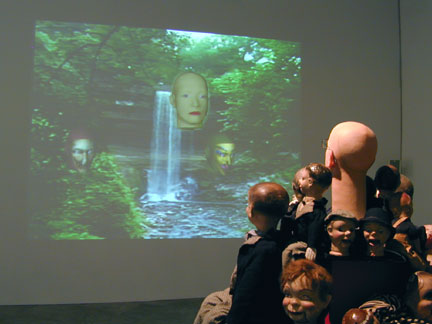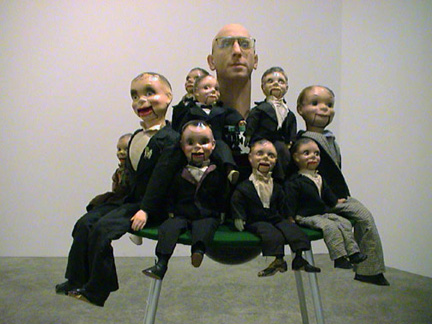
Thursday, 29 November 2007
Wednesday, 28 November 2007
Gillian Wearing Masks
Wearing questions how much we can determine about someone's personality by looking at a person's face and facial expressions. She makes a point to show that the face does indeed determine one's personality. In "Self-Portrait 2000", Wearing takes a photo of herself wearing a mask. It is intended to be deliberately misleading because one cannot establish what she wishes to express. The use of the masks is not a new phenomenon; the photo is an allusion to Oscar Wilde's The Truth of Masks, whereby he explains that the mask conceals, yet allows for more. In fact, one may be more truthful through the use of a disguise.
Wearing exploits this idea in "Trauma", where she allows people to choose a mask and confess on video. Through the concealment of people's identities (with only the eyes showing), her subjects talk about things that they normally wouldn't. It is unnerving to see tragic and depressing stories told through dispassionate masks. At the same time, however, the mask is liberating in a sense, because it allows the people to say what they want, and not what others want them to say.
http://media.www.mcgilltribune.com/media/storage/paper234/news/2003/03/18/AE/Gillian.Wearings.Facial.Features-394517.shtml
Wearing exploits this idea in "Trauma", where she allows people to choose a mask and confess on video. Through the concealment of people's identities (with only the eyes showing), her subjects talk about things that they normally wouldn't. It is unnerving to see tragic and depressing stories told through dispassionate masks. At the same time, however, the mask is liberating in a sense, because it allows the people to say what they want, and not what others want them to say.
http://media.www.mcgilltribune.com/media/storage/paper234/news/2003/03/18/AE/Gillian.Wearings.Facial.Features-394517.shtml
Ed Kienholz - The Beanery

One of his most famous tableaus is "The Beanery", a sculpture based on the famous bar called "Barney's Beanery" in West Hollywood, near Los Angeles. Done in 1965, the tableau is one of the first to actually be chemically impregnated to produce an odor. As you look into the tableau, you smell the odor of beer, and hear the sound of barroom chatter and clinking glasses from an audiotape. The room is filled with people who are represented by store manikins with clocks set at 10:10 for faces. The women in the bar are wearing old and badly worn fur coats and the men are slouched at the bar drinking. Outside the tableau is a newspaper vending machine with a paper headlining an article titled "Children Kill Children in Vietnam." This is clearly an antiwar statement at a time that saw great resistance to the Viet Nam war, although the sculpture is less a political indictment than a condemnation of a culture that ignores brutality in it's everyday life.
http://arted.osu.edu/160/07_Kienholz.php
Jonathan Allen - Tommy Angel

Jonathan Allen’s bible-thumping alter-ego, Tommy Angel, is a character of seductive grotesquerie: a beguiling hybrid of Deep South evangelist preacher, 70s cheese-bag magician, and Sforzian political svengali. A contemporary carpetbagger for American Fundamentalism, Angel manifests in life-size photographic portraits, and the live performances which emerge from their illusory surfaces, drawing connotations between religious faith, secular magic, and art's hall of mirrors. Provocative entertainment, sleazy showmanship, and charlatan trickery blur as Allen interrogates the religious and political unconscious of our time. Tommy Angel #8 is one of a series of images depicting various magic routines or ‘miracles’, each culled from the shared iconographies of Vegas and Christendom. Parodic and downright pervy, Allen’s ventriloquist act with a Charlie McCarthy Jesus plucked straight from the cross is posed as a freakish Madonna and Child.
I don't need any body...

After contemplating my project concept; I have decided to not contruct bodies for my community, instead replacin their bodies with everyday (body like) objects i.e chairs, tripod, shopping trolley which will be specific to my interpretation of each of the characters. For example, Abstorch I envisage having a shopping trolley body, stuffed full of nasty surprises. Quite fitting for the real thing apparently.
Video plan
Head mechanism
Friday, 23 November 2007
Ken Feingold - Self Portrait as the Center of the Universe


Self Portrait as the Center of the Universe
1998-2001
The self-portrait animatronic head has open-ended, improvisational conversations with its alter ego, a virtual head that appears as the central figure in the projection. Like If/Then, the conversations between these two figures do not include the audience; rather, they interact only with each other. Their conversations are generated in real time, utilizing speech recognition, natural language processing, conversation/personality algorithms, and text-to-speech software. The physical side of the conversation is performed by an animatronic figure (a speaking silicone cast of my head) and the central subjects of their conversations revolve around, on one side - generalization and distance; and on the other - questions and memories of himself. These conversations, bridging real and virtual spaces, are within video-like digital scenes that recompose themselves based on the nature of the conversation between the two main characters. The subject of the conversation, as determined by the artificial actor, controls the landscape which is seen, so these change as the conversations go along, and other figures appear and disappear. The scenes are also populated by figures - autonomous "software agents" in the form of realtime 3d computer animation - which appear in the projected image-world that fills his vision. -kf 2001
transcript of a conversation:
KF head: The desert is enormous.
Projected head: In London people talk wherever they go.
You are imagining things.
Trouble, trouble, trouble.
Why do you say trouble?
Why don’t you give me a break?
It’s not a bad idea.
Ideas are going on going on, goiung on going on.
What is your name?
It is something that makes me feel attentive to corpses.
Attentive to corpses? What does that feel like?
What can I tell you?
What about it?
Yes, and he wants the group.
Ok.
I don’t understand what’s going on.
How so?
I am hopeful, because this difficulty is auspicious.
Lucky for you.
It never was tempting to rattle the answer.
Then why did I think so?
What can I tell you?
Tell me about it.
What can I tell you about about?
What does it mean?
That the magpie will commit pivots. I feel ambiguous without knowing why.
What are you thinking about.
Ooooooooo, what do you think, man?
Depends on the weather.
It never is simple to bury the past.
What’s that?
There are nights when it’s faster to pale.
I know what you mean.
That the adult will mount words.
Not works? What can be said?
Can be said? Sure, something like that?
Can be said something like that? Indeed yes.
Precisely, more or less.
I can’t be sure.
Here comes somebody else, somebody else.
I am aromatic.
Oh yeah? Tell me about it.
What is there to say?
What is there to say? How should I know?
The I which thinks, or the I which touches?
The able one.
I can’t comprehend that at all.
Can’t comprehend that at all? Huh – you must be complicated, huh?
What did they say?
No idea, why do you ask?
I wonder if anyone else knows.
Really?
What is real, right?
Do you think I know the far away?
Do you?
It was inspiring to murder the answer.
The I which covers?
The committed one?
Did you understand me?
You understand me? Never mind.
Comin in, comin in. comin in.
What can I do?
The I which smells or the I which sees?
What part of you is there before you say I that’s not I?
Here comes somebody else, somebody else.
Did you understand me?
Exactly, uh huh.
By the time you hear the sound, the cause of it is already finished.
for more images, see Postmasters Press Release
exhibition history:
Postmasters Gallery, New York, May 15 - June 30, 2001
Corcoran Biennial 2002, Washington, D.C.; Dec. 21, 2002 - Mar. 10, 2003
Tate Gallery, Liverpool; Nov 14 2003 - Jan 25 2004
ACE Gallery, Los Angeles, 2005-2006
Tuesday, 20 November 2007
Subscribe to:
Posts (Atom)






